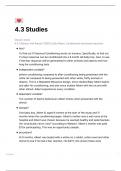4.3 Studies
Classic study
4.3.1 Watson and Rayner (1920) Little Albert: Conditioned emotional reactions
Aim?
To find out if Classical Conditioning works on humans. Specifically, to find out
if a fear response can be conditioned into a 9 month old baby boy. Also, to see
if the fear response will be generalised to other animals and objects and how
long the conditioning lasts
Independent variable?
before-conditioning compared to after-conditioning being presented with the
white rat compared to being presented with other white, fluffy animals or
objects. This is a Repeated Measures design, since studies Baby Albert before
and after his conditioning, and also since studies Albert with the rat and with
other stimuli. Albert experiences every condition.
dependent variable?
The number of fearful behaviours Albert shows when presented with the
stimuli.
Sample?
One baby boy, Albert B, aged 9 months at the start of the study and 11
months when the conditioning began. Albert’s mother was a wet nurse at the
hospital and Albert was chosen because he seemed healthy and quite fearless
(he “practically never cried” according to Watson). Albert's mother was paid
$1 for participating. This was an opportunity sample.
procedure?
At 9 months, Albert was tested with a white rat, a rabbit, cotton wool and other
stimuli to see if he had a fear reaction. He didn’t; this shows these were
4.3 Studies 1
, Neutral Stimuli (NS)
The researchers also checked his fear response by banging an iron bar. Albert
cried at the loud noise; this shows the noise was an Unconditioned Stimulus
(UCS) and the crying was and Unconditioned Response (UCR).
At 11 months, Albert was conditioned. He was shown the white rat three times.
Each time the rat was paired with striking the iron bar. Albert started to
whimper. A week later, Albert was conditioned again. The rat was presented 3
times, paired with the noise.
Watson & Rayner also moved Albert to a lecture theatre with 4 other people.
Albert’s reactions to the rat and the rabbit were the same. This is transferral of
response to other settings.—> control. this eliminates extraneous variables
such as the environment Albert was originally in.
results?
When the rat was later presented alone, Albert whimpered. The rat was paired
with the noise again 2 more times. When the rat was presented alone another
time, Albert cried. This suggests that the NS is now a Conditioned Stimulus
(CS) and Albert’s crying is a Conditioned Response (CR)
Over the next 10 days, Watson & Rayner tested Albert’s reaction to the rat and
to other white, furry animals and objects like a rabbit, a dog and Watson
wearing a Santa mask. Albert showed fear responses to the rat like
whimpering and crawling away; he showed similar reactions to the rabbit
(cried) and Santa mask and a lesser reaction to the dog (crawled away, cried
when it approached). This is generalisation of response
They tested Albert again a month later and found the same reactions, though
slightly weaker. Watson & Rayner intended to use Classical Conditioning to
remove the conditioned responses from Albert, but his mother moved away
and took Albert with her so the experiment ended.
conclusion?
Watson & Rayner concluded that they had successfully conditioned Albert to
fear the white rat and that his fear response generalised to other white, furry
things (with a stronger response the more closely they resembled the rat)
and transferred to other situations.
4.3 Studies 2


